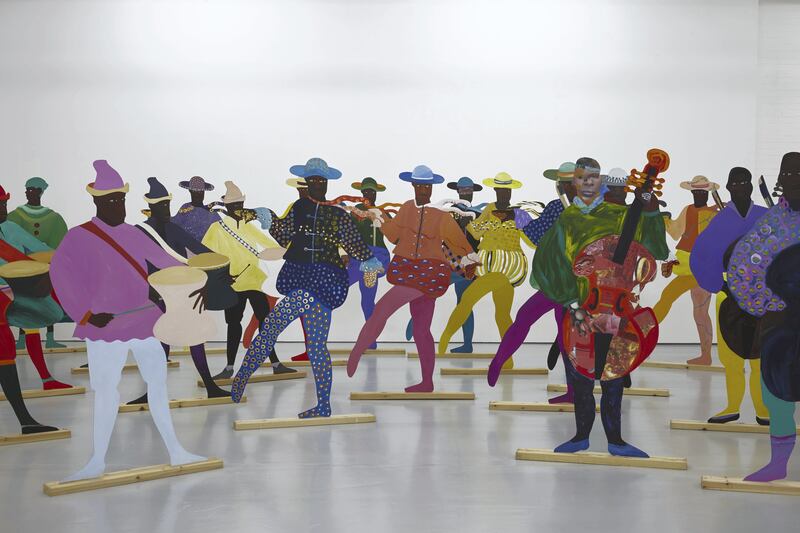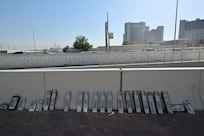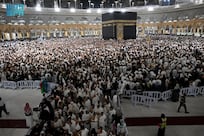It’s rather fitting that in the first year since the Turner Prize, Britain’s highest award for the visual arts, allowed artists older than 50 to enter, Lubaina Himid should be the hot favourite to pick up the £40,000 (Dh189,000) bounty for the winner. The 62-year-old mixed-race artist, who operates predominantly as a painter but also works in other media, has become a hot property relatively late in to her career.
This year alone, she has had two extremely well-received shows in Britain, Invisible Strategies at Modern Art Oxford and Navigation Charts at Spike Island in Bristol, as well as being part of a group show at Nottingham Contemporary called The Place Is Now, all of which earned her the nod from the Turner committee. She is now being celebrated in Warp and Weft, a survey by Firstsite gallery in Colchester, Essex.
It’s a coup for Firstsite to have secured such a retrospective, as director Sally Shaw notes. “In a year in which Firstsite is exploring issues of identity, and in a climate in which migration and immigration are particularly contentious, we are delighted to be staging this major presentation of Lubaina’s work.
“Throughout her 40-year career, Lubaina has unflinchingly explored the history, impact and contribution of migration in western culture, in particular that of the experience of black people in the United Kingdom,” Shaw continues. “The work that has been brought together for this show, all of which was produced in the last 15 years, is as beautiful as it is thought-provoking, and is an insight into a significant and influential artist.”
Born in 1954 in Zanzibar – part of Tanzania – to an African father and a (white) English mother who had met as students in London, Himid moved back to Britain when she was just four months old after her father died of malaria. Despite spending her formative years and her working life in the country, she still is keenly aware of her roots through her father’s side.
"I always felt a deep awareness of my African heritage," she told The Times. "It was not that we talked about it every day or anything — my mother was always very keen that I should just fit in — but I suppose I felt African because I had an African name." As a mixed-race artist, she felt that she was empowered "to see the differences and to make the connections" that contemporaries of hers may have missed.
She first came to notice during the 1980s as a member of the Black Arts Movement, helping fellow artists to break through into what was then a very monocultural art scene. Her work focuses on examining the experiences of minority communities, through repression and racial bias, and giving a voice to the people who had previously been muted.
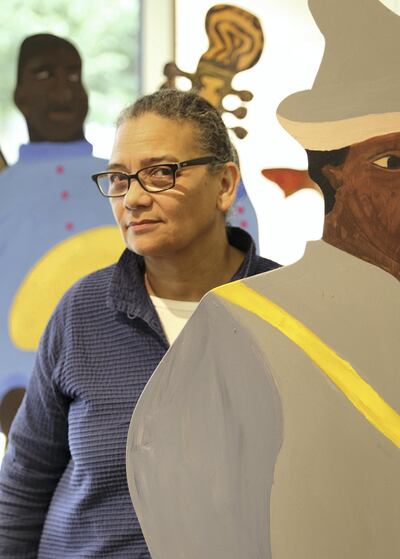
Naming the Money, a work which dates from 2004, is the largest installation at the FirstSite show and features Himid's signature 'cut-outs' – freestanding boards that are painted with characters on them, a nod to her early training in theatrical set design.
There are 70 of these in the survey, colourfully portraying the African slaves who served in the royal courts of 18th century Europe. A soundtrack gives these mute boards a voice, exploring their original heritage in Africa through their original names, and contrasting this with the monikers and roles imposed on them.
Another large-scale work, Cotton.com (2002), a series of 83 small-scale paintings addresses another key moment in African history that often escapes the historical record. During the American Civil War in the 1860s, British workers in the cotton mills of Lancashire voluntarily refused to process cotton which had been grown by the Confederate states, who were fighting to maintain slavery in the United States.
At great personal and economic costs, including mass unemployment and the subsequent poverty that resulted in, cotton workers’ unions stood firm and enforced the blockade. Himid has said, “The point I am often exploring vis-à-vis the black experience is that of being so very visible and different in the white Western everyday yet so invisible and disregarded in the cultural, historical, political or economic record or history.”
A text that runs alongside the portraits imagines a dialogue between workers on two continents which is explored through pattern rather than language. Indeed the thread of cotton runs strongly through the collection of works. The exhibition’s title refers to the process by which threads are held taut on a loom to create cloth. It acknowledges Colchester’s historical position in the wool trade.
Another piece in the show, an ongoing work called Negative Positives: The Guardian Archive (2007 - 2017) is a series of pages from the newspaper painted over by Himid. She chose stories which highlighted negative news about the black community – stories about violence and drugs – next to representations of successful black people.
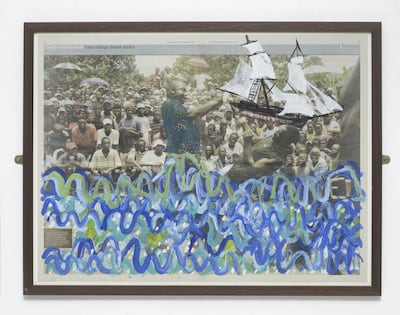
Himid explains the work by saying that “the invented and borrowed patterns on each page are painted to highlight this strange and inappropriate use of people as signifiers and finally to vent my spleen. Every day in Britain even the ‘liberal’ press is simultaneously visualising and making invisible black peoples’ lives.”
While there have undoubtedly been major advances in racial harmony in Britain and across the world in recent times, Himid’s work is a reminder of the history that underpins these relations, and stresses how fragile the gains that have been made could be.
1 July - 1 October 2017
http://firstsite.uk/whats-on/lubaina-himid-warp-weft/
_________________________
Read more:
[ British artist Zarah Hussain's Numina gives traditional Islamic patterns a digital overhaul ]
[ Street art brings colour to rundown Beirut suburb ]
[ Why I will always remember the Louvre Abu Dhabi I saw first ]
_________________________
